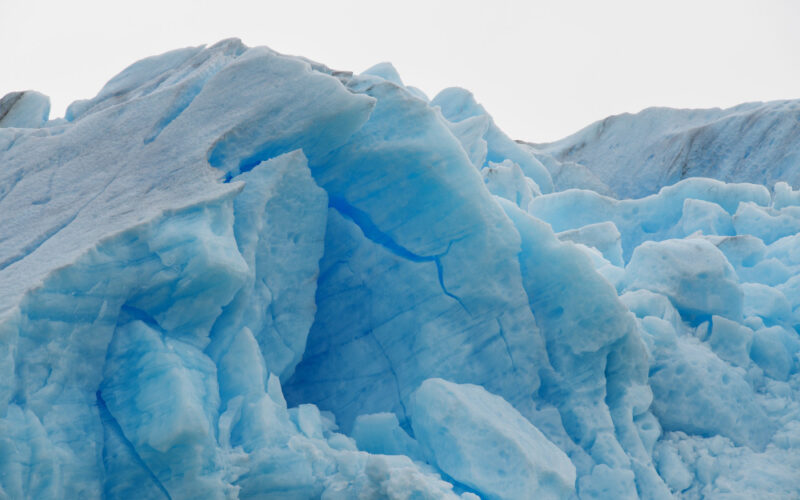What is permafrost?
Permafrost is a state in which ice has not melted and has been preserved through low average temperatures for a long time. The area where this phenomenon occurs is called a permafrost zone. This phenomenon occurs in Antarctica, which has averagely cold weather, or in high-altitude areas. This phenomenon also occurs in areas located at low latitudes but at high elevations, such as tundra. The permafrost structure is separated into three layers: an active layer that is impacted by temperature fluctuations such as warm and cold weather; permafrost that has been frozen for a long period of time (more than two years); and unfrozen ground that has not frozen even in cold weather. Because permafrost did not thaw for a long time and stayed frozen, carbon has not decomposed and remains deeply buried beneath the ice. If the Arctic ice melts, the deeply buried carbon will be exposed. In this case, carbon levels on Earth would rise, as would the greenhouse effect, generating difficulties such as an increase in the global average temperature (Vartan, 2022).
Why is the polar ice melting?
The Arctic was always able to maintain a constant low temperature because the effects of solar heat were lower than elsewhere. And the glaciers in the Arctic reflect the sun’s heat to keep the Earth’s temperature properly. However, the usage of substances such as coal for technological growth has resulted in an increase in the Earth’s average temperature, raising the same concern as global warming. Because melting glaciers cannot reflect the sun’s heat, the Earth absorbs it in its entirety. In other words, global warming has caused Arctic glaciers to melt. Because of global warming, Svalbard’s glaciers have vanished. Svalbard’s glaciers have disappeared due to global warming. Even in the summer, Svalbard maintained a low temperature, retaining the look of glaciers; nevertheless, the temperature of the Earth’s atmosphere climbed, leading glaciers to melt in the summer due to rising temperatures (Nol and Broke, 2020). There was also an unusual occurrence of mosquitoes in the Arctic. This is because rising temperatures in the Earth’s atmosphere caused the glaciers to melt, resulting in massive pools of water. Warm temperatures and puddles increased the mosquito population because there was plenty to go around. These mosquitoes have caused diseases, such as infections, in animals living in the Arctic. In other words, the Arctic ecosystem is changing into a serious situation (WELCH, 2015). In conclusion, global warming has caused glaciers to melt, reducing animals in the Arctic, reducing food for people living in the Arctic, and causing various problems.
Will melting glaciers cause the dangerous viruses of the past again?
Various problems can arise if the temperature of the Earth’s atmosphere rises and the glaciers in the Arctic melt. Problems such as carbon may occur, but the most serious problem is that dangerous viruses can be exposed. In 2016, a herd of reindeer suddenly died on the Yamal Peninsula in Russia. The cause of the reindeer’s death is anthrax. Anthrax is the cause of the reindeer’s death. The anthrax virus is a terrible virus that has killed many people but is now extinct and no longer exists on Earth. However, reindeer who died of anthrax were buried in the glacier. However, rising temperatures caused the glaciers to melt, and reindeer with anthrax came out of them. As a result, a herd of reindeer was infected with anthrax, and the reindeer died (DOUCLEFF, 2019). In other words, if the Earth’s temperature increases and the permafrost melts, the virus buried in the permafrost will revive. Also, we don’t know what viruses exist in permafrost glaciers. If a virus that is resistant to antibiotics appears on Earth, our safety will be in danger.
Conclusion
Permafrost is a state in which the temperature remains low for more than two years and the ice does not melt but remains frozen. Global warming has caused the Earth’s temperature to rise above average, forcing the Arctic glaciers to melt. This glacier carries harmful viruses as well as carbon. If glaciers disappear, carbon emissions will exacerbate global warming and endanger our health as numerous and hazardous pathogens resurface. That is why we must address environmental issues so that global warming is no longer a severe threat.
References
DOUCLEFF, M. (2019). NPR Choice page. [online] Npr.org. Available at: https://www.npr.org/sections/goatsandsoda/2016/08/03/488400947/anthrax-outbreak-in-russia-thought-to-be-result-of-thawing-permafrost [Accessed 24 March 2023].
Noël, B. and Broeke, M. van den (2020). Svalbard glaciers lost their protective buffer in the mid-1980s and have been melting ever since. [online] The Conversation. Available at: https://theconversation.com/svalbard-glaciers-lost-their-protective-buffer-in-the-mid-1980s-and-have-been-melting-ever-since-146706 [Accessed 24 March 2023].
Vartan, S. (2022). What Is Permafrost? [online] Treehugger. Available at: https://www.treehugger.com/what-is-permafrost-5095196 [Accessed 24 March 2023].
WELCH, C. (2015). Why the Arctic’s Mosquito Problem Is Getting Bigger, Badder. [online] Animals. Available at: https://www.nationalgeographic.com/animals/article/150915-Arctic-mosquito-warming-caribou-Greenland-climate-CO2 [Accessed 24 March 2023].
